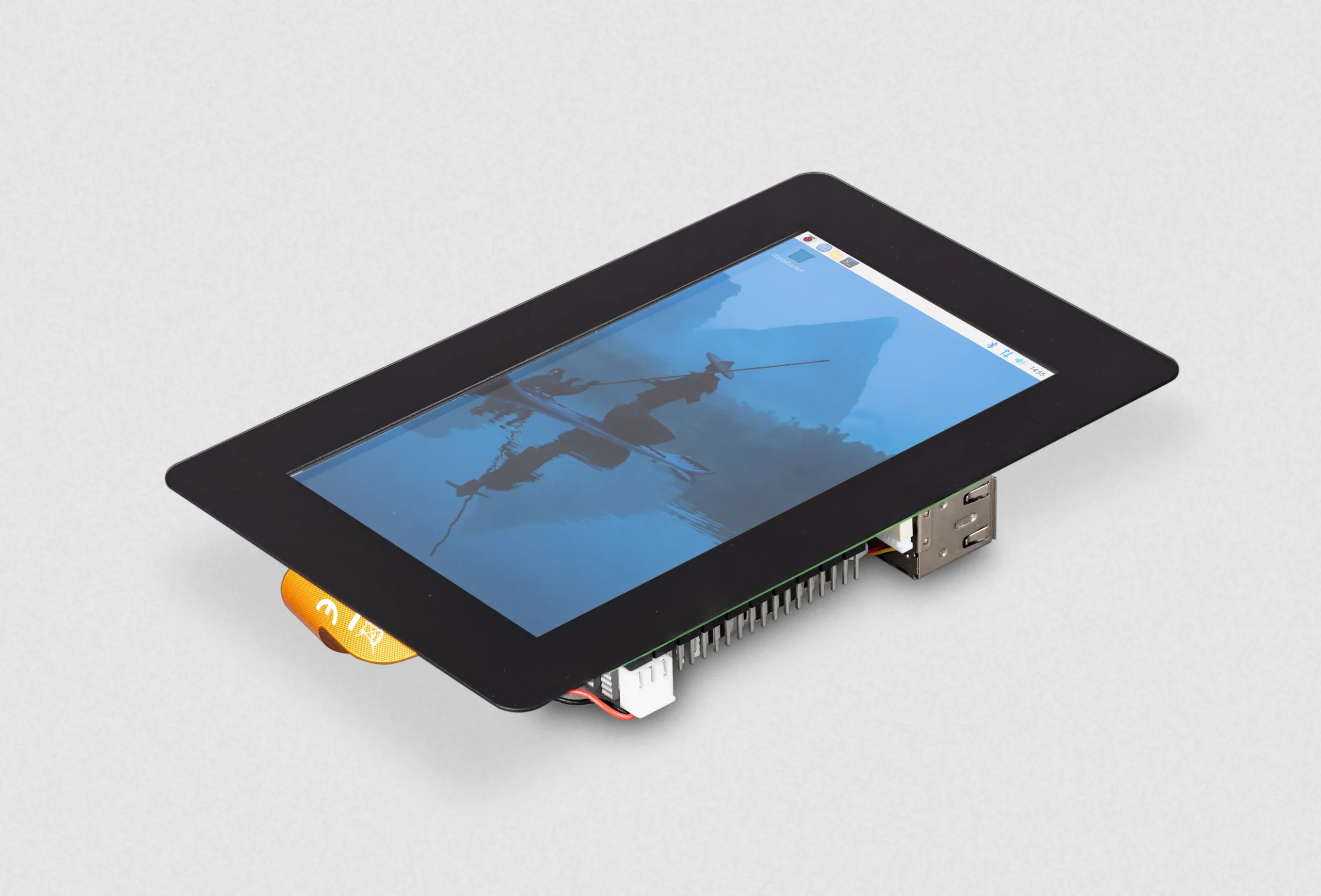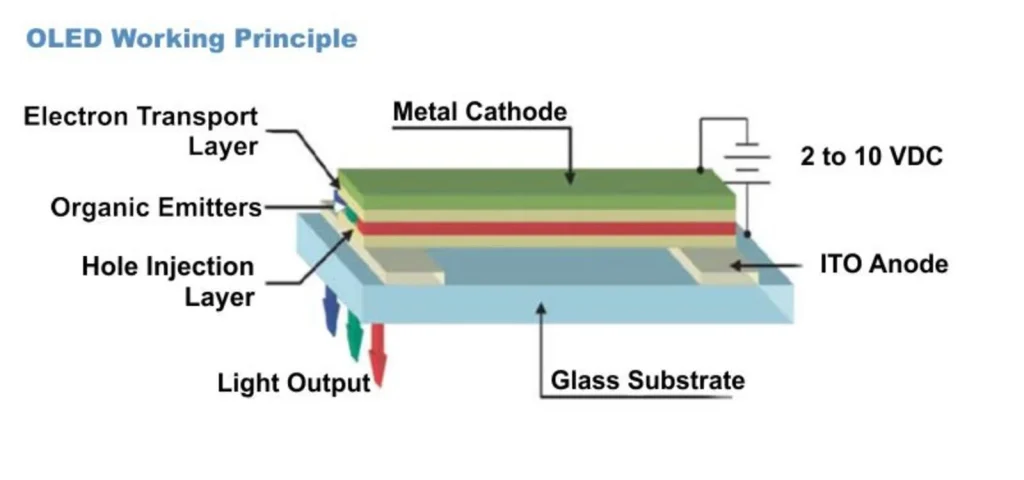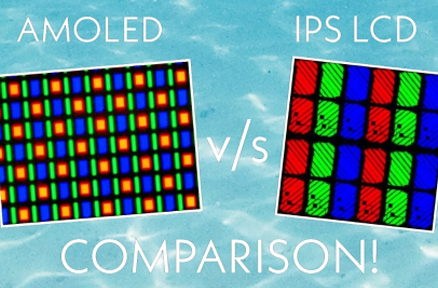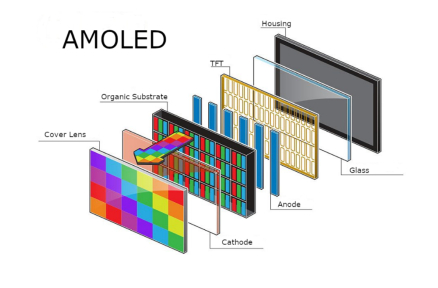OLED screens bring a big leap forward in screen tech. They stay much thinner and lighter than old schermi LCD. As OLED tech grows popular in many fields, it turns into a handy pick for all kinds of uses.

What is an OLED?
OLED, or Organic Light-Emitting Diode, acts like a light diode. It makes light when power runs through its glow part. Unlike LCD screens that need back lights, OLEDs use natural stuff to create light right away.
This setup cuts power use, boosts sharp differences, gives deep dark spots, and makes colors look full and bright.
Flat screens made with OLED tech show up in many areas. These include home gadgets, factory controls, health checks, and car screens. The thin shape, low power need, quick replies, and big view angles make OLED screens perfect for phones, smart watches, control boards, lab tools, and car panels.
OLED Layer Structure
The basic build of an OLED screen has the cathode, anode, glow layer (the light-making natural part), and lead layer. These parts work together, helping light come out well and keeping power flowing smooth.

Organic Materials Used in OLEDs
The cathode is a metal or lead layer that sends electrons. The anode lets power move and often uses clear leads like indium tin oxide (ITO). People like ITO for its good power flow and clear look.
Between the anode and cathode sit the natural layers that make light when power hits. The lead layer may use plastics like polyaniline. For the glow layer, natural mixes like Tris(8-hydroxyquinoline) aluminum, polyfluorene, or triphenylamine work as main materials. Makers pick them for certain OLED plans and work needs.
These natural materials let exact control of light traits and help the tech fit in tough, high-work spots.
How Do OLEDs Work?
An OLED runs as a special LED. Its glow layer comes from natural mixes that light up when power goes on. This layer has a plastic base stuck between a cathode and an anode. Power wakes the natural bits and makes them send out light bits.
OLEDs act like normal LEDs in concept but change by using natural layers instead of hard rock ones. This gives bend and better work. This natural base helps grow screen size and aids fitting in factory and health uses.
How OLEDs Produce Light
OLEDs use a light trick from power—materials glow when electricity runs through. A natural layer sits between a cathode and anode. When volts hit, electrons go from cathode to anode. Holes (good charges) move the other way. They meet in the natural layer, and energy comes out as light bits.
Diagram of How OLEDs Produce Light
Volts go across the cathode and anode.
Electrons flow from cathode to anode.
This makes extra electrons at the cathode and forms holes in the lead layer.
They meet at the glow-lead edge.
Light bits come out—you see bright light.
The light color depends on the natural stuff mix. This lets changes for jobs that need set light types, like health pictures or car HUDs.
OLED Advantages
OLED screens beat LCDs in many ways. Their natural thin and light build fits carry and built-in systems. These include phones, laptops, fitness bands, AR/VR sets, and wear items.
Bigger view angles and wide heat ranges top normal TN LCDs. They give full view fun. Better sharp differences make dark spots deep and clear edges sharp. Low power helps the earth. Bright true colors, fast replies, and real darks lift user fun in all fields.
Key OLED Advantages
Thin and light build
High sharp differences
Wide work heats
Bright color make
Big view angles
Deep dark spots
Quick reply times
Low power need
These traits put OLEDs as best for business fits in hard spots, like factory controls and health tools.
OLED Disadvantages
No back lights limit OLED bright scale next to LCDs. Inside views shine, but direct sun may hurt clear read. Natural stuff wear links to bright levels—it can cut life in heavy use.
Make steps stay hard now. They push costs up over LCD make, but big make plans promise lower prices soon.
Key OLED Disadvantages
Shorter work life than LCDs
Higher power pull with white-heavy stuff
Less clear read in direct sun
Higher start costs than LCDs
Even with these issues, new ideas fix weak points and boost fit for big firm sets.
Conclusione
OLED tech changes screen ways with self-glow, bend panels. They reach never-seen thin and light.
Used in phones, TVs, monitors, tablets, smart watches, fitness bands, health gear, car meters, sound sets, headsets, cameras, and game boxes—OLEDs use natural bend for new plans.
Applications and Future Trends
The tech keeps growing fast. More firms pick OLED for its clear views and low power. In health, doctors see sharp pictures on portable tools. In cars, drivers get bright HUDs that stay clear day or night.
In factories, controls reply quick and last in hot or cold spots. Kadi Display stays ahead, adding new sizes and bright levels often. Buyers get parts that fit exact needs. No big order minimums help small tests. Quick samples speed up work, and the tech team aids every step.
OLED fits grow in IoT gadgets too. Small sensors need tiny screens that sip power—OLED gives that. And it bends for curved watches or round badges. Colors pop true. Blacks stay pure. No light leak ruins dark scenes in games or videos.
But care matters:
Keep bright low when possible to stretch life. Cover from sun for outdoor use. Pick good manufacture like Display Kadi to avoid early wear. Their parts pass tough tests and work in dust, shake, or wet air.
Join the OLED Wave
More buyers join the OLED wave. Over 2,000 firms trust Kadi already. New ones start easy—send mail or visit site.
Ask for a quote on 15.6-inch AMOLED or slim modules. See how they boost your product. Fast reply comes. Samples ship quick. Full support follows.
OLED Leads the Future of Screens
Thin, bright, efficient—perfect for modern needs. Join now and build better.
Domande frequenti
Q1: What distinguishes OLED from LCD technology?
OLED panels glow light from natural stuff direct—no back lights. This makes thinner shapes and true darks. LCDs need back lights, use more power, and give less sharp differences.
Q2: Are OLED displays suitable for industrial environments?
Yes. Factory-grade OLEDs from places like Kadi Display handle wide heats. They give high bright for control boards and auto systems.
Q3: How does OLED lifespan compare to LCD?
OLEDs may wear quicker at high bright. But new steps stretch use to match or beat LCDs in normal jobs.
Q4: Can OLEDs be customized for projects?
Sure. Makers like Kadi Display give fit OLED parts with links like MIPI, LVDS, and touch skills for set resolutions and sizes.
Q5: What applications benefit most from OLED?
Health tools, car panels, and carry IoT gain from OLED’s sharp, low power, and bend.
Partner with Kadi Display – Your Trusted OLED Manufacturer and Supplier
Kadi Display stands as a top OLED maker and supplier. It brings new, fit display answers to lift factory and health jobs. No MOQ rules, fast first models, and full tech help make working with Kadi Display easy and efficient.
Reach Kadi Display now at Sales@sz-kadi.com to request a quote.
Find how our 15.6-inch AMOLED panels or slim OLED modules can better your next build. Join over 2,000 happy buyers—begin your custom OLED path today.
Ultimi Blog & Notizie
- OLED – Organic Light Emitting Diode
- Passive Matrix vs Active Matrix - A Beginner's Guide
- Which Display for Raspberry Pi Interface Optimizes Touch Control: DSI MIPI or HDMI?
- Power of Industrial TFT LCD Touch Screen: Revolutionizing Interactivity
- Qual è la differenza tra anti-riflessione e anti-abbagliamento?
Blog & Notizie correlate
-
TN contro IPS2024-7-9
-
TN contro IPS2024-7-9









